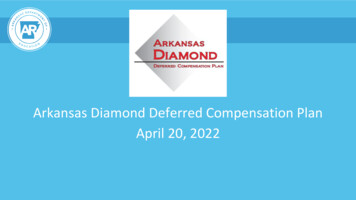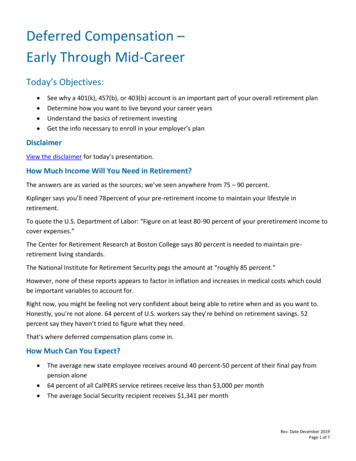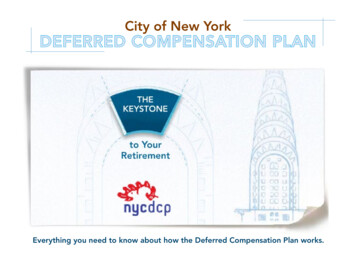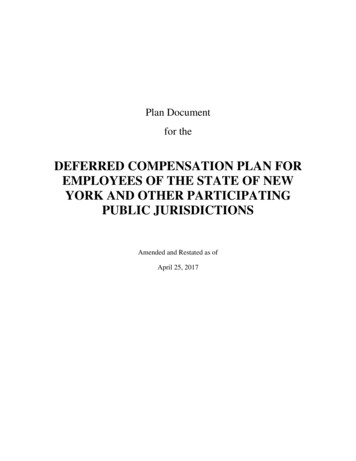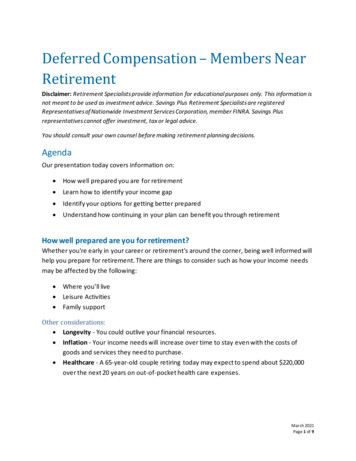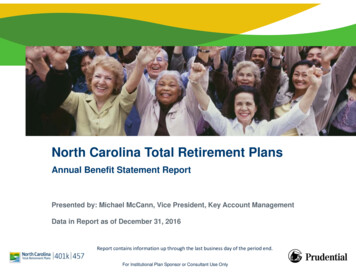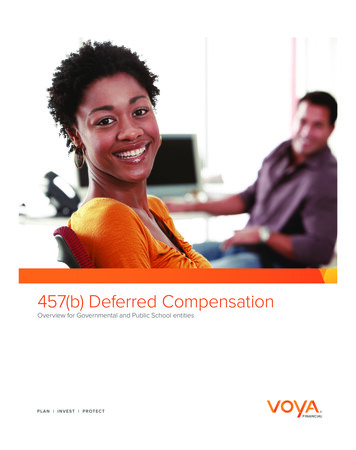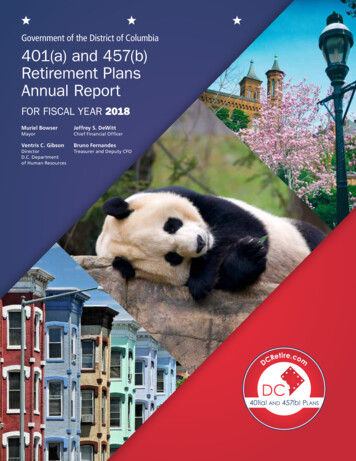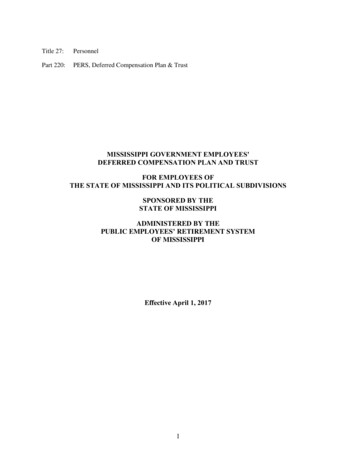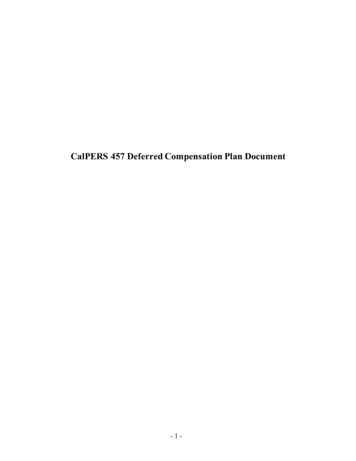
Transcription
CalPERS 457 Deferred Compensation Plan Document-1-
TABLE OF CONTENTSArticle I - Definitions .51.1 Account .51.2 Adoption Agreement .51.3 Beneficiary .51.4 Board.51.5 Code.51.6 Deferral .51.7 Deferral Agreement.51.8 Eligible Deferred Compensation Plan .61.9 Employee.61.10 Employer .61.11 Fund .61.12 Government Code .61.13 Includible Compensation .61.14 Investment Option .61.15 Normal Retirement Age.61.16 Participant.71.17 CalPERS.71.18 Plan .71.19 Rehired Employee.71.20 Required Beginning Date.71.21 Roth Elective Deferrals .71.22 Self-Managed Account .71.23 Severance from Employment .71.24 Transfer .71.25 Trustee.71.26 Unforeseeable Emergency .71.27 Year.8Article II - Employer Participation .82.1 Initial Participation .82.2 Terms of Participation .82.3 Duration of Employer Participation .8Article III - Employee Participation .83.1 Eligibility.83.2 Initial Enrollment .83.3 Effect of Deferral Agreement.93.4 Amendment of Deferral Agreement .93.5 Investment Options .93.6 Beneficiary Designation.93.7 Additional Deferrals.103.8 Roth Elective Deferrals .10Article IV - Deferral Limitations.114.1 General Limitation .114.2 Age 50 Catch-up Deferral Contributions .114.3 Special Section 457 Catch-up Limitation .114.4 Special Rules .124.5 Deferrals Prior To or After Severance from Employment, Including Sick, Vacation, and-2-
Back Pay .134.6 Correction of Excess Deferrals.134.7 Protection of Persons Who Serve in a Uniformed Service .13Article V - Participant Accounts .145.1 Crediting of Accounts.145.2 Account Balances.14Article VI - Distributions.146.1 Commencement of Distributions upon Severance from Employment.146.2 Optional Distribution Forms .156.3 Deferred Commencement Date .156.4 In-Service Distributions From Rollover Account .156.5Cash-outs and Combined Payments .156.6 Unforeseeable Emergency Distributions .166.7 Death Benefits .166.8 Uniformed Service Member Distributions .176.9 Latest Distribution Date.176.10 Distributions/Rollovers from Fund .17Article VII – Transfers and In-Plan Conversions .187.1 Acceptance of Transfers .187.2 Eligible Rollover Contributions to the Plan.187.3 Transfers to other Plans .197.4 Transfer Conditions.197.5 Permissive Service Credit Transfers .207.6 In-Plan Roth Conversions.20Article VIII – Loans.208.1 Loans.208.2 Maximum Loan Amount.208.3 Terms of Loan.218.4 Security for Loan; Default .218.5 Repayment.21Article IX - Participant Rights .229.1 Participants' Interest in the Fund.229.2 Benefits Based on Account Balances.229.3 Nonassignability .229.4 Transfers under Domestic Relations Orders.229.5 Release from Liability to Participant .239.6 Participation in Legal Proceedings .23Article X - Terms of Fund Investments .2310.1 Use of Fund .2310.2 Administration of Fund .2310.3 Investment Options .2410.4 Fund Investments .2410.5 Valuation and Accounting .2410.6 Redemption Restrictions.25Article XI - Administration of Plan .2511.1 Duties of Board .2511.2 Delegation of Authority .2511.3 Duties of Employer .25-3-
11.4 Plan Expenses .2611.5 Communications from Participants .2611.6 Communications to Employers .2711.7 Communications to Participants.2711.8 Time Periods.27Article XII - General Provisions .2712.1 Amendment .2712.2 Effect on Employment.2712.3 Binding Contract.2712.4 Supplementary Information and Procedures .2812.5 Incompetence of Payee .2812.6 Inability to Locate Beneficiary.2812.7 Applicable Law.28-4-
The purpose of the California Public Employees' Deferred Compensation Plan (the “Plan”) is toprovide deferred compensation for California public employees that elect to participate in the Plan.This Plan is established pursuant to sections 21670 through 21685 of the Government Code of theState of California and is intended to constitute an "eligible deferred compensation plan" within themeaning of section 457 of the Federal Internal Revenue Code. Except as otherwise providedherein, this amendment and restatement of the Plan is effective March 1, 2019.Article I - DefinitionsThe following terms when used herein shall have the following meaning:1.1Account: The bookkeeping account maintained with respect to each Participant whichreflects the value of the deferred compensation credited to the Participant, including theParticipant's Deferrals, the earnings or loss of the Fund (net of Fund expenses) allocable to theParticipant, any Transfers for the Participant's benefit, and any distributions made to the Participantor the Participant's Beneficiary.If a Participant has more than one Beneficiary at the time of the Participant’s death, then a separateAccount Balance shall be maintained for each Beneficiary. The Account Balance includes anyaccount established under Section 7.2 for rollover contributions and plan-to-plan transfers made fora Participant, the account established for a Beneficiary after a Participant’s death, and any accountor accounts established for an alternate payee (as defined in section 414(p)(8) of the Code).1.2Adoption Agreement: The agreement under which an Employer becomes a participatingEmployer under this Plan.1.3Beneficiary: The person or persons designated by the Participant to receive distributionsfrom the Participant's Account after the Participant's death. A designated person may include, butis not limited to, one or more of the following: an individual, trust, corporation or firm, or theestate of the Participant. A designation shall be made on a Board-approved beneficiary designationform.1.4Board: The Board of Administration of CalPERS.1.5Code: The Federal Internal Revenue Code of 1986, as amended from time to time.1.6Deferral: An amount credited to a Participant's Account by reason of the Participant'sagreement to contribute a portion of his or her salary or wages to the Plan.1.7Deferral Agreement: The agreement between an Employer and an Employee, includingany amendments thereto, which specifies the amount of Deferrals to be made by the Employee.Each Deferral Agreement or amendment thereto shall be made or confirmed in writing underprocedures established by the Board.-5-
1.8Eligible Deferred Compensation Plan: An eligible governmental plan as defined inSection 1.457-2(f) of the Income Tax Regulations.1.9Employee: Any individual who is a common law employee of an Employer and is amember of CalPERS or for whom the Board is otherwise authorized to administer this Plan underthe Government Code. An Employee does not include an independent contractor.1.10 Employer: Any political subdivision of the State of California, or any agency orinstrumentality of the State of California or political subdivision of the State of California forwhich the Board is authorized to administer this Plan under the Government Code and that hasbecome a participating employer under this Plan pursuant to Article 2. Where required by thecontext, references to the Employer shall mean the current or former Employer of the Employee orParticipant.1.11 Fund: The Public Employees' Deferred Compensation Fund that has been established aspart of the Plan pursuant to section 21676 of the Government Code. For purposes of Section 9.1 ofthis Plan, the Fund shall not include the asset management and services account maintainedpursuant to section 21678 of the Government Code.1.12 Government Code: Those statutes of the State of California that have been codified as theGovernment Code.1.13 Includible Compensation: A Participant's compensation, as defined in Section 415(c)(3) ofthe Code, for services performed for the Employer. Includible Compensation shall be determinedwithout regard to any community property laws.1.14 Investment Option: One of the available alternatives for crediting investment earnings to aParticipant's Account, which shall be based upon the performance of one or a combination of theinvestment portfolios maintained under the Fund.1.15 Normal Retirement Age: The age used to determine the three-year period in which aParticipant may utilize the catch-up limitation under Section 4.3. A Participant may designate ashis or her Normal Retirement Age an age that is not earlier than age 62 and that is not later thanage 70-1/2. Notwithstanding the preceding sentence, a Participant may designate as his or herNormal Retirement Age an age that is earlier than age 62 if the Participant can demonstrate thatsuch age is not earlier than the age the Participant will attain in the earliest Year in which theParticipant will be eligible to retire without actuarial or similar reduction under CalPERS oranother retirement system.Once a Participant has utilized the catch-up limitation under Section 4.3 or under a comparableprovision of another Eligible Deferred Compensation Plan that Participant's Normal RetirementAge may not thereafter be changed. An Employer sponsoring more than one Eligible DeferredCompensation Plan may not permit a Participant to have more than one Normal Retirement Ageunder the Eligible Deferred Compensation Plans it sponsors.-6-
1.16 Participant: Any Employee or former Employee for whom a Deferral has been creditedunder the Plan and for whom an Account is maintained.1.17CalPERS: The California Public Employees' Retirement System.1.18 Plan: The California Public Employees' Deferred Compensation Plan established pursuantto sections 21670 through 21685 of the Government Code, the terms of which are set forth in thisPlan document. To the extent required under section 457 of the Code, each Employer'sparticipation in this Plan shall be treated as a separate plan, and each Employer's separate plan shallbe deemed to include any other Eligible Deferred Compensation Plan maintained by that Employer.1.19 Rehired Employee: An Employee who has had a Severance from Employment with anEmployer, and thereafter becomes an Employee of that Employer. An Employee shall be treatedas a Rehired Employee on the date he or she becomes reemployed with the Employer.1.20 Required Beginning Date: April 1st of the Year following the Year of a Participant'sattainment of age 70-1/2 or Severance from Employment, whichever is later.1.21 Roth Elective Deferrals: A Deferral that is: (a) Designated irrevocably by the Participantat the time of the Deferral Agreement as a Roth Elective Deferral that is being made in lieu of allor a portion of the pre-tax elective Deferrals the Participant is otherwise eligible to make under thePlan; and (b) Treated by the employer as includible in the Participant’s income at the time theParticipant would have received that amount in cash if the Participant had not made a cash ordeferred election.1.22 Self-Managed Account: A brokerage account established by a Participant through whichsuch Participant makes self-directed investments with respect to amounts reflected in theParticipant’s account.1.23 Severance from Employment: The date that the Employee dies, retires, or otherwise has aseverance from employment with the Employer, as determined by the Employer (and taking intoaccount guidance issued under the Code). A Rehired Employee shall no longer be treated as havinga Severance from Employment upon the date of his or her rehire.1.24 Transfer: An amount credited to a Participant's Account by reason of a transfer fromanother Eligible Deferred Compensation Plan.1.25Trustee: The Board of Administration of CalPERS.1.26 Unforeseeable Emergency: A severe financial hardship of the Participant resulting from:an illness or accident of the Participant, the Participant's spouse, the Participant’s domestic partnerpursuant to a state domestic relations law who is a designated primary Beneficiary or theParticipant's dependent (as defined in Section 152(a) of the Code, without regard to Section152(b)(1), (b)(2), and (d)(1)(B)); loss of the Participant's property due to casualty (including the-7-
need to rebuild a home following damage to a home not otherwise covered by homeowner'sinsurance, e.g., as a result of a natural disaster); the need to pay for the funeral expenses of theParticipant's spouse or dependent (as defined in Section 152(a) of the Code, without regard toSection 152(b)(1), (b)(2), and (d)(1)(B)); or other similar extraordinary and unforeseeablecircumstances arising as a result of events beyond the control of the Participant. For example, theimminent foreclosure of or eviction from the Participant's primary residence may constitute anUnforeseeable Emergency. In addition, the need to pay for medical expenses, including nonrefundable deductibles, as well as for the cost of prescription drug medication, may constitute anUnforeseeable Emergency. A need to send a child to college or to purchase a new home shall notconstitute an Unforeseeable Emergency.1.27Year: A calendar year.Article II - Employer Participation2.1Initial Participation: This Plan shall be available to the Employees of an Employer only ifthe Employer has executed an Adoption Agreement and provided the Board with such informationas the Board deems necessary to administer the Plan on behalf of the Employer. CalPERS, in itssole discretion, will decide whether an Employer may participate in this Plan.2.2Terms of Participation: By executing an Adoption Agreement, an Employer agrees toadhere to all terms and conditions of the Plan, as amended from time to time, to invest all Deferralsand Transfers in the Fund, and to follow all administrative procedures established by the Board.Except as otherwise provided herein, the terms of this Plan shall apply on a uniform basis to allEmployers participating hereunder. The Board may, in its soles discretion, upon sixty (60) daysadvance written notice terminate an Adoption Agreement with an Employer for participation of itsEmployees in the Plan.2.3Duration of Employer Participation: In the event that an Employer withdraws fromparticipation in the Plan, all amounts credited to the Accounts of the Employer's participatingEmployees will continue to be held in the Fund and will be distributed in accordance with the termsof the Plan, except to the extent of any transfers from the Plan pursuant to Section 7.3.Article III - Employee Participation3.1Eligibility: Except as provided in section 21670 of the Government Code, all Employees ofan Employer shall be eligible to participate in the Plan. Notwithstanding the above, an Employeewho is a minor may only participate in this Plan to the extent he or she may enter into anenforceable contract that cannot be disaffirmed by the minor.3.2Initial Enrollment: In order to become a Participant, an Employee must enter into aDeferral Agreement, which shall become effective no earlier than the calendar month following themonth in which the agreement is made. A Deferral Agreement will be given effect only if theDeferral amount elected therein satisfies whatever minimum the Board may establish, and theEmployee provides all information called for on the agreement form.-8-
3.3Effect of Deferral Agreement: Commencing with the effective date of an Employee'sDeferral Agreement, his or her gross salary or wages shall be reduced by the Deferral amountspecified in the Deferral Agreement. Deferrals shall continue to be made in such amount unless anduntil the Deferral Agreement is amended or the Employee has a Severance from Employment withthe Employer. Subject to the limitations of Article 4, Deferrals shall not be subject to Federal orCalifornia income tax withholding and shall not be reported as gross income on the Employee'sannual wage statement (Form W-2). However, Deferrals shall be subject to FICA taxation whenearned.3.4Amendment of Deferral Agreement: A Participant may amend or revoke his or herDeferral Agreement at any time, provided, however, that no change in the amount of a Participant'sDeferrals will become effective until the calendar month following the month in which the DeferralAgreement is amended.3.5Investment Options: Upon initial enrollment in the Plan, the Participant’s future Deferralwill be invested in the Plan’s designated “default” option for investment of contributions unless theParticipant makes an affirmative investment election to the contrary prior to the date his or herDeferral is first invested. To the extent the Participant does not wish to have his or hercontributions invested in the designated “default” Investment Option, the Participant maydesignate another Investment Option or Investment Options to which his or her Deferrals are to beallocated or elect to make investments through a Self-Managed Account. A Participant maythereafter re-allocate his or her Account balance among the available Investment Options orthrough a Self-Managed Account. The minimum amounts or percentages that may be allocatedamong Investment Options and/or through a Self-Managed Account, and the timing and frequencyof re-allocations, shall be subject to such limitations and procedures as the Board may from time totime establish. In addition, investments and trading with respect to a Self-Managed Account willbe subject to any rules or restrictions adopted by the third party provider that administers suchaccounts. The Board, in its sole discretion, may make available to Participants certain investmentguidance services or investment advice services through a third party provider. Such services maybe utilized only at the voluntary election of a Participant and shall not limit a Participant’sresponsibility for the allocation of his or her Accounts in and among the Investment Options. TheBoard may eliminate the availability of such services at any time.3.6Beneficiary Designation: Upon enrollment, the Participant shall designate a Beneficiary toreceive distributions from the Participant's Account in the event of the Participant's death. Suchdesignation shall be made in a form and manner prescribed by the Board. A Participant may change hisor her designated Beneficiary at any time, provided that an amended Beneficiary designation shallbe given effect only if it is made by the Participant in a form and manner prescribed by the Board anddelivered to a Plan representative (or post-marked for delivery) prior to the Participant's death. TheBoard may allow a Beneficiary designation or change in Beneficiary designation to be made through useof an electronic medium to the extent permitted by applicable law. The last Beneficiary designationform made by the Participant and delivered to a Plan representative as described above shall revokeall prior Beneficiary designations. A Participant may designate any person or persons asBeneficiaries, except as described below. Unless otherwise provided in the Beneficiary designation-9-
form, each designated Beneficiary shall be entitled to equal shares of the benefits payable after theParticipant's death. If the Participant fails to designate a Beneficiary, or if no designatedBeneficiary survives the Participant for a period of fifteen (15) days, or a beneficiary designationform is not in good order, then the estate of the Participant shall be the Beneficiary.Notwithstanding the foregoing, a Participant's Beneficiary designation shall not be given effect andshall be overridden to the extent that such a designation would impair the rights of any survivingspouse under applicable law. For example, if the Participant is legally married or in a registereddomestic partnership, the Participant may not designate a non-spouse or non- domestic partner asthe Participant’s sole primary Beneficiary, as applicable, without a valid written waiver from theParticipant’s spouse or domestic partner. Failure to satisfy state law requirements with respect to aParticipant’s Beneficiary designation shall invalidate the Beneficiary designation to such nonspouse or non-domestic partner.3.7Additional Deferrals: An Employer may make additional Fund investments with respect toany Employee, resulting in additional credits to the Account of such
: The California Public Employees' Retirement System. 1.18 Plan: The California Public Employees' Deferred Compensation Plan established pursuant to sections 21670 through 21685 of the Government Code, the terms of which are set forth in this Plan document. To the extent required under section 457 of the Code, each Employer's
